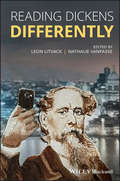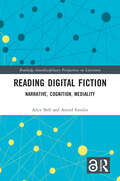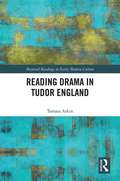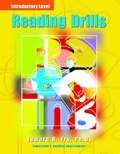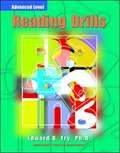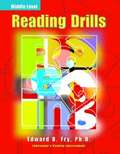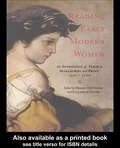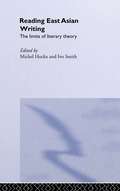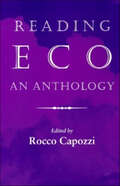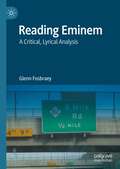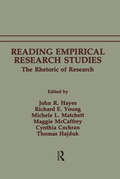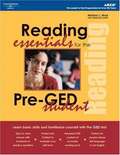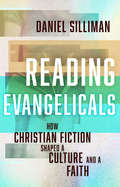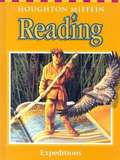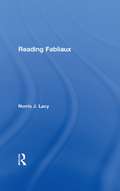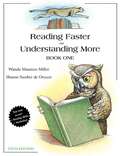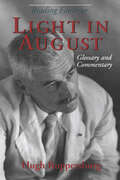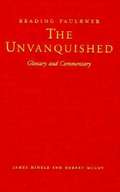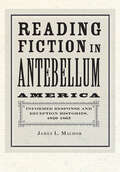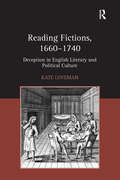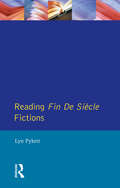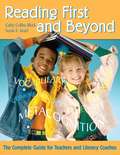- Table View
- List View
Reading Dickens Differently
by Leon Litvack Nathalie VanfasseA collection of original essays and innovative reading strategies—provides examples of reading Dickens in creative and challenging ways Reading Dickens Differently features contributions from many of the field’s leading scholars, offering creative ways of reading Dickens and enriching understanding of the most celebrated author of his time. A diverse range of innovative reading strategies—archival, historical, textual, and digital—representing new and exciting approaches to contemporary literary and cultural studies. This groundbreaking volume brings together literature, history, politics, painting, illustration, social media, video games, and other topics to reveal new opportunities to engage with the author's life and work. This unique book includes a re-evaluation of Dickens’ death and burial, new research data drawn from legal records and newspapers, assessments of well-known paintings and lesser-known illustrations, experimental readings of Dickens’ texts in digital form, and more. Much of the evidence presented has never been seen before, such as Dickens' funeral fee account from Westminster Abbey, Dickens' death certificate, and a telegram from Dickens' son asking for urgent assistance for his dying father. Revising and refreshing the critical strategies of traditional Dickens studies, this important volume: Features new research data on aspects of Dickens's life Discusses a range of innovative reading strategies (including physiological novel theory) for clarifying aspects of Dickens' work Examines the presence of Dickens in popular media and technology, such as Assassin’s Creed video game and A Christmas Carol iPad app Features rare illustrations, including documents and images relating to Dickens's death and funeral Edited by world authorities on Dickens and his manuscripts Authoritative, yet accessible, Reading Dickens Differently is a must-have book for Dickens specialists, instructors and students in Victorian fiction and Dickens courses, as well as general readers lookingfor innovative reading strategies of the author's work.
Reading Digital Fiction: Narrative, Cognition, Mediality (Routledge Interdisciplinary Perspectives on Literature)
by Astrid Ensslin Alice BellReading Digital Fiction offers the first comprehensive and systematic theoretical, methodological, and analytical examination of digital fiction from a cognitive and empirical perspective. Proposing the new concept of “medial reading”, it argues for the centrality of an audience’s interest in, awareness of and/or attention to the medium in which a text is produced and received, and which we argue should be applied to reader data across media. The book analyses and theorises five generations of digital fiction and their reading including hypertext fiction, hypermedia fiction, narrative video games, app fiction, and virtual reality. It showcases medium- and platform-specific methods of qualitative reader response research across a variety of contexts and settings from screen-based and embodied interaction to gallery installation, and from reading group and individual interview to think-aloud methodologies. The book thus addresses the unique affordances of digital fiction reading by designing and reporting on new empirical studies focusing on hypertextuality, interactivity, immersion, as well as medium-specific forms of textual “you”, ontological ambiguity, reader orientation and empathy. In so doing, the book refines, critiques, and expands cognitive, transmedial, and empirical narratology and stylistics by placing the reader of these new narratives front and centre.The Open Access version of this book, available at http://www.taylorfrancis.com, has been made available under a Creative Commons [Attribution-Non Commercial-No Derivatives (CC-BY-NC-ND)] 4.0 license.
Reading Diversity through Canadian Picture Books
by Ingrid Johnston Joyce BainbridgeWhat is the value of picture books in educating a diverse society? This collection of original essays explores how preservice teachers from faculties of education across Canada engage with issues of diversity and national identity as represented in children's picture books. Based on research drawn from education courses and student teaching experiences, the book illustrates new and culturally relevant approaches to curricula that meet the needs of increasingly diverse student bodies.The volume focuses on picture books as a central body of texts, drawing on recent reading theory and exploring the implications of bringing the works into school classrooms. Together, the essays offer a unique cross-Canada perspective on how picture books can help students and teachers explore identities, uncover personal and national histories, and locate a sense of place.
Reading Drama in Tudor England: Drama, Reading And The Invention Of The Literary (Material Readings in Early Modern Culture)
by Tamara AtkinReading Drama in Tudor England is about the print invention of drama as a category of text designed for readerly consumption. Arguing that plays were made legible by the printed paratexts that accompanied them, it shows that by the middle of the sixteenth century it was possible to market a play for leisure-time reading. Offering a detailed analysis of such features as title-pages, character lists, and other paratextual front matter, it suggests that even before the establishment of successful permanent playhouses, playbooks adopted recognisable conventions that not only announced their categorical status and genre but also suggested appropriate forms of use. As well as a survey of implied reading practices, this study is also about the historical owners and readers of plays. Examining the marks of use that survive in copies of early printed plays, it explores the habits of compilation and annotation that reflect the striking and often unpredictable uses to which early owners subjected their playbooks.
Reading Drills (Reading Drills)
by Edward B. FryReading Drills helps students prepare for standardized tests. Students build their reading stamina, practicing reading longer passages in a timed setting. They also improve both their literal and critical thinking skills and have additional opportunities for longer personal responses. Like a standardized test, both fiction and nonfiction selections are presented.
Reading Drills Advanced Level (Reading Drills)
by Edward B. FryReading Drills is a three-level series, with classic and contemporary fiction and nonfiction readings, designed to teach students how to improve their reading speed while building valuable comprehension and critical thinking skills.
Reading Drills Middle Level (Reading Drills)
by Edward B. FryReading Drills is a three-level series, with classic and contemporary fiction and nonfiction readings, designed to teach students how to improve their reading speed while building valuable comprehension and critical thinking skills.
Reading Early Modern Women: An Anthology of Texts in Manuscript and Print, 1550-1700
by Elizabeth Sauer Helen OstovichMuch has been written about women of the English Renaissance, but few examples of women's writing from that era have been readily available until now. This remarkable anthology assembles for the first time 144 primary texts and documents written by women between 1550 and 1700 and reveals an unprecedented view of the intellectual and literary lives of women in early modern England. The writings range from poetry to philosophical treatises, addressing a wide array of subjects including law, gender, education, motherhood, medicine, religion, life-writing, and the arts. Each selection is paired with a beautifully reproduced facsimile of the text's original source manuscript, allowing a glimpse into the literary past that will lead the reader to truly appreciate the care and craft with which these women writers prepared their texts. This essential anthology is a captivating guide to the legacy of early modern women's literature and its authors that must not be overlooked.
Reading East Asian Writing: The Limits of Literary Theory (Routledgecurzon--iias Asian Studies Ser.)
by Michel Hockx Ivo SmitsThis book presents contributions by thirteen scholars of Chinese and Japanese literature whose work is characterised by a strong interest in literary theory. They focus in particular on the various new theories that have emerged during the past two decades, uprooting traditional forms of understanding literary texts, their function, their readership and their interpretation. Often confined to discussion of a specific country or area, these theories have been criticised for their Western bias.This collection breaks through these barriers, providing an opportunity for scholars of two closely related yet often independently studied cultures to present and compare their views on specific theories of literature, to discuss the advantages and shortcomings of those theories, and to consider specific difficulties related to the East-West dimension.
Reading Eco: An Anthology (Advances in Semiotics)
by Rocco Capozzi"[READING ECO is a timely indication] of the fruitfulness of perceiving Eco as the same in his metamorphoses. [It also testifies] to a certain price that Eco and his readers must/may pay for the enormous pleasure and intellectual stimulus of being Eco and being with Eco." —The ComparatistUmberto Eco is, quite simply, a genius. He is a renowned medievalist, philosopher, novelist, a popular journalist, and linguist. He is as warm and witty as he is learned—and quite probably the best-known academic and novelist in the world today. The goal of this anthology is to examine his ideas of literary semiotics and interpretation as evidenced both in his scholarly work and in his fiction.
Reading Eminem: A Critical, Lyrical Analysis
by Glenn FosbraeyThis book critically analyses Eminem’s studio album releases from his first commercial album release The Slim Shady LP in 1999, to 2020’s Music To Be Murdered By, through the lens of storytelling, truth and rhetoric, narrative structure, rhyme scheme and type, perspective, and celebrity culture. In terms of lyrical content, no area has been off-limits to Eminem, and he has written about domestic violence, murder, rape, child abuse, incest, drug addiction, and torture during his career. But whilst he will always be associated with these dark subjects, Mathers has also explored fatherhood, bereavement, mental illness, poverty, friendship, and love within his lyrics, and the juxtaposition between these very different themes (sometimes within the same song), make his lyrics complex, deep, and deserving of proper critical discussion.The first full-length monograph concerning Eminem's lyrics, this book affords the same rigorous analysis to a hip-hop artist as would be applied to any great writer's body of work; such analysis of 'popular' music is often overlooked. In addition to his rich exploration of Eminem's lyrics, Fosbraey furthermore delves into a variety of different aspects within popular music including extra-verbal elements, image, video, and surrounding culture. This critical study of his work will be an invaluable resource to academics working in the fields of Popular Music, English Literature, or Cultural Studies.
Reading Empirical Research Studies: The Rhetoric of Research
by John R. Hayes, Richard E. Young, Michele L. Matchett, Maggie McCaffrey, Cynthia Cochran, Thomas HajdukFor the most part, those who teach writing and administer writing programs do not conduct research on writing. Perhaps more significantly, they do not often read the research done by others because effective reading of articles on empirical research requires special knowledge and abilities. By and large, those responsible for maintaining and improving writing instruction cannot -- without further training -- access work that could help them carry out their responsibilities more effectively. This book is designed as a text in graduate programs that offer instruction in rhetoric and composition. Its primary educational purposes are: * to provide models and critical methods designed to improve the reading of scientific discourse * to provide models of effective research designs and projects appropriate to those learning to do empirical research in rhetoric. Aiming to cultivate new attitudes toward empirical research, this volume encourages an appreciation of the rhetorical tradition that informs the production and critical reading of empirical studies. The book should also reinforce a slowly growing realization in English studies that empirical methods are not inherently alien to the humanities, rather that methods extend the power of humanist researchers trying to solve the problems of their discipline.
Reading Essentials For The Pre-GED Student
by Melissa L. Masi Stephanie SmithPart of the five-book Essentials for the Pre-GED Student series, Reading Essentials reviews the fundamentals for students like you who need extra help with their reading comprehension skills. There is both a pretest and a posttest to determine your strengths and weaknesses. The lessons are written in an easy-to-read format, and this unique guide is sure to help you gain the skills you need to prepare for the GED.
Reading Evangelicals: How Christian Fiction Shaped a Culture and a Faith
by Daniel SillimanThe story of five best-selling novels beloved by evangelicals, the book industry they built, and the collective imagination they shaped Who are evangelicals? And what is evangelicalism? Those attempting to answer these questions usually speak in terms of political and theological stances. But those stances emerge from an evangelical world with its own institutions—institutions that shape imagination as much as they shape ideology. In this unique exploration of evangelical subculture, Daniel Silliman shows readers how Christian fiction, and the empire of Christian publishing and bookselling it helped build, is key to understanding the formation of evangelical identity. With a close look at five best-selling novels—Love Comes Softly, This Present Darkness, Left Behind, The Shunning, and The Shack—Silliman considers what it was in these books that held such appeal and what effect their widespread popularity had on the evangelical imagination. Reading Evangelicals ultimately makes the case that the worlds created in these novels reflected and shaped the world evangelicals saw themselves living in—one in which romantic love intertwines with divine love, humans play an active role in the cosmic contest between angels and demons, and the material world is infused with the literal workings of God and Satan. Silliman tells the story of how the Christian publishing industry marketed these ideas as much as they marketed books, and how, during the era of the Christian bookstore, this—every bit as much as politics or theology—became a locus of evangelical identity.
Reading Expeditions
by J. David Cooper John J. PikulskiThis book combines poems, stories, plays, personal essays, and articles that add new perspectives on the theme or subject matter of the longer work.
Reading Fabliaux (Garland Library of Medieval Literature #Vol. 1805)
by Norris J. LacyDetailed readings of 10, and lighter discussions of many others, of the 150 medieval French bawdy poems that scholars generally find it necessary to discuss as a whole, thereby missing important individual characteristics.
Reading Faster And Understanding More
by Wanda M. Miller Sharon Steeber De OrozcoStrategies for improving reading speed and comprehension.
Reading Faster and Understanding More
by Sharon Steeber De Orozco Wanda Maureen MillerThe Reading Faster, Understanding More developmental workbooks recognize the inseparable links between comprehension, vocabulary and reading rate. With vocabulary and study skills instruction integrated throughout, each chapter guides students through the reading comprehension and rate improvement processes and includes exercises to practice these skills. Book 1 features lively readings-from the 6th to 8th grade level--on the Fry test, with the "textbook" chapter at the 9th grade level. For anyone interested in reading comprehension.
Reading Faulkner: Light in August (Reading Faulkner Series)
by Hugh RuppersburgExplaining the world of William Faulkner's Light in August is the primary goal of this glossary. Like other books in this series, it explains, identifies, and comments on many elements that a reader may find unfamiliar or difficult. These include the basic features of Faulkner's fictional town of Jefferson and Yoknapatawpha County, colloquialisms, dialects, folk customs and sayings, farm implements, biblical verses, and geographic and demographic details. Written especially for puzzled readers, teachers of Faulkner, graduate students, and interpretive scholars, the Reading Faulkner Series books offer terms and explications that reveal the richly cultural world in Faulkner's major works. Page references throughout are keyed to the definitive editions of Faulkner published by Library of America and to the Vintage editions prepared from the Library of America tapes.
Reading Faulkner: The Unvanquished
by Noel Polk James C. Hinkle Robert MccoyDiscusses specific pages in the book and provides commentary.
Reading Fiction in Antebellum America: Informed Response and Reception Histories, 1820–1865
by James L. MachorJames L. Machor offers a sweeping exploration of how American fiction was received in both public and private spheres in the United States before the Civil War. Machor takes four antebellum authors—Edgar Allan Poe, Herman Melville, Catharine Sedgwick, and Caroline Chesebro'—and analyzes how their works were published, received, and interpreted. Drawing on discussions found in book reviews and in private letters and diaries, Machor examines how middle-class readers of the time engaged with contemporary fiction and how fiction reading evolved as an interpretative practice in nineteenth-century America.Through careful analysis, Machor illuminates how the reading practices of nineteenth-century Americans shaped not only the experiences of these writers at the time but also the way the writers were received in the twentieth century. What Machor reveals is that these authors were received in ways strikingly different from how they are currently read, thereby shedding significant light on their present status in the literary canon in comparison to their critical and popular positions in their own time.Machor deftly combines response and reception criticism and theory with work in the history of reading to engage with groundbreaking scholarship in historical hermeneutics. In so doing, Machor takes us ever closer to understanding the particular and varying reading strategies of historical audiences and how they impacted authors’ conceptions of their own readership.
Reading Fiction with Lucian
by Karen Ní MheallaighThis book offers a captivating new interpretation of Lucian as a fictional theorist and writer to stand alongside the novelists of the day, bringing to bear on his works a whole new set of reading strategies. It argues that the aesthetic and cultural issues Lucian faced, in a world of mimesis and replication, were akin to those found in postmodern contexts: the ubiquity of the fake, the erasure of origins, the focus on the freakish and weird at the expense of the traditional. In addition to exploring the texture of Lucian's own writing, Dr ní Mheallaigh uses Lucian as a focal point through which to examine other fictional texts of the period, including Antonius Diogenes' The Incredible Things Beyond Thule, Dictys' Journal of the Trojan War and Ptolemy Chennus' Novel History, and reveals the importance of fiction's engagement with its contemporary culture of writing, entertainment and wonder.
Reading Fictions, 1660-1740: Deception in English Literary and Political Culture
by Kate LovemanEnglish society in the late seventeenth and early eighteenth centuries was fascinated by deception, and concerns about deceptive narratives had a profound effect on reading practices. Kate Loveman's interdisciplinary study explores the ways in which reading habits, first developed to deal with suspect political and religious texts, were applied to a range of genres, and, as authors responded to readers' critiques, shaped genres. Examining responses to authors such as Defoe, Swift, Richardson and Fielding, Loveman investigates reading as a sociable activity. She uncovers a lost critical discourse, centred on strategies of 'shamming', which involved readers in public displays of reason, wit and ironic pretence as they discussed the credibility of oral and written narratives. Widely understood by early modern readers and authors, the codes of this rhetoric have now been forgotten, to the detriment of our perception of the period's literature and politics. Loveman's lively book offers a striking new approach to Restoration and eighteenth-century literary culture and, in particular, to understanding the development of the novel.
Reading Fin de Siècle Fictions (Longman Critical Readers)
by Lyn PykettThe fin de siècle, the period 1880-1914, long associated with decadence and with the literary movements of aestheticism and symbolism, has received renewed critical interest recently. The essays in this volume form a valuable introduction to fin de siècle cultural studies and provide a commentary on important aspects of current critical debate and the place of culture in society.
Reading First and Beyond: The Complete Guide for Teachers and Literacy Coaches
by Cathy Collins Block Susan E. IsraelPacked with enriching ideas for all educators, this guide summarizes the key areas of the Reading First program to provide a comprehensive understanding of its components.
